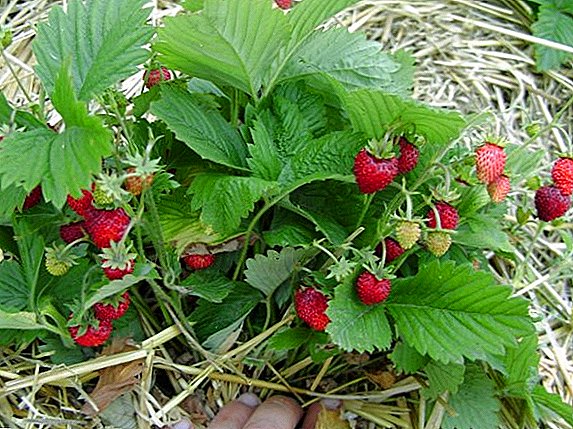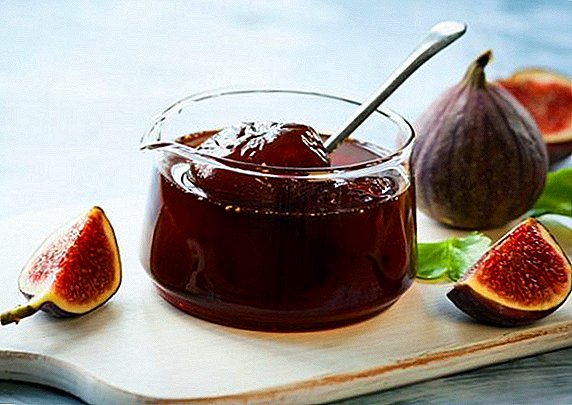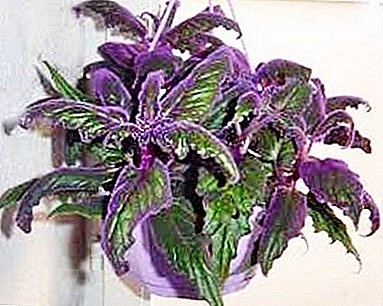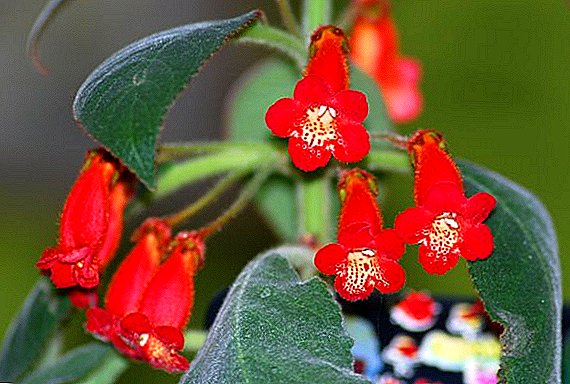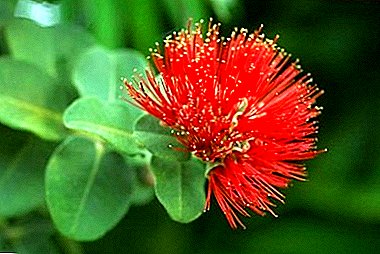
Metrosideros is a beautiful evergreen flowering plant of the myrtle family.It has more than 50 species in the wild of tropical and subtropical islands.
Types of plants with photos
"Metrosideros High" (the second name is felt) - An evergreen plant belonging to the myrtle family grows at home in the form of a small tree (in the wild, Metrosideros can reach a height of 25 meters) with rigid, elastic leaves of saturated oval green color with sharp ends and a small edge.
Homeland plants is New Zealand, the natives of which - the Maori tribe consider this plant the main plant of their people and worship as sacred.
The flower is a small rosette of many thin stamens, the color range of inflorescences from bright red (the most common color) to yellow and pinkish.

"Metrosideros Carmine" - got its name from the colors of carmine color. An important distinctive feature of this cultivar shrub for home cultivation is its almost year-round flowering.
The plant has small rounded leaves with a slightly blunt end, it easily takes the necessary shape when cutting the shoots.

"Metrosideros Changeable" (the second name is "Polymorph") - arrived to us from the Hawaiian Islands, where it is considered the sacred plant of the goddess Pele (the deity of fire and volcanoes).
"Metrosideros" (Polymorph) - an excellent honey plant, which received its name for the ability to acquire any form (liana, shrub, tree), depending on the growing conditions; and a variety of colors (in addition to the standard yellow, red and pink, can please even orange and salmon flowers.
The leaves have a dense, oval-elliptical shape with small points on the tips.
"Metrosideros Sparkling" (the second name is climbing) - Evergreen vine, which at home can reach 1.5 meters.
It grows in the form of a compact bush, individual branches can reach a length of 3-4 meters, for which he received its second name. The leaves are leathery, emerald green in color, have a slightly elongated round shape, blooms from August to December.

Home care
 At home, Metrosideros is unpretentious, but it requires adherence to certain axiom rules, like all myrtle ones: a large, sunny, air-saturated space.
At home, Metrosideros is unpretentious, but it requires adherence to certain axiom rules, like all myrtle ones: a large, sunny, air-saturated space.
A mixture of coarse fractional sand, ordinary garden soil (preferably sheet), moist humus or peat, and sod soil mixed in approximately the same amount is used as the soil.
Before laying the soil in a flower pot, it is necessary to make high-quality effective drainage, since the root system of Metrosederos does not like strong dampness.
Excessive moisture can cause the roots to rot, and the plant itself to wilt, flowers and leaves.
Lighting and temperature content
Important! Temperature conditions for comfortable maintenance of the Metrosideros + 12 + 22.Going beyond these temperatures can cause foliage and flowers to drop.
Metrosideros is very fond of light and open spaces, so it’s best to place the plants on the windows facing south and southeast.
Watering
Water "Metrosideros" must be abundant, but not too often (in the summer it is enough once a week, in the winter no more than once in 10-12 days), necessarily with soft water. Spraying the leaves is very useful, especially during the dry season, but water droplets should not be allowed to fall on the flowers.
Top dressing
 Fertilize any myrtle plants, including Metrosideros, you need at least 2 times a month with organic fertilizers or fertilizer complexes that do not contain lime, from March to August.
Fertilize any myrtle plants, including Metrosideros, you need at least 2 times a month with organic fertilizers or fertilizer complexes that do not contain lime, from March to August.
In summer, it is better to take the plant to fresh air (for example, to the garden or to the balcony).
In winter, it is necessary to observe the temperature regime not lower than +12. (+10 is considered critical temperature for the plant) and provide the plant with good illumination.
Trimming "Metrosideros" to give shape (for example, for Japanese art, "Bonsai" is an artificially grown copy of this tree) in February, after the end of the period of active flowering.
Breeding
Transplantation of plants is carried out in the spring, as the roots of earthy coma are woven to adulthood. Young plants need to be transplanted 1 time per year, more adults every 3-4 years.
Subsequently, it is sufficient to simply add soil or change its top layer. The first transplant is required immediately after purchase, and the pot must be 5 centimeters more than the one in which the plant was purchased.
Metrosideros breeds in two ways:
Seeds
This method is quite complicated and is possible only under certain conditions:
- Freshly harvested seeds must be sown immediately, the longer the storage, the lower the germination rate of the crop;
- The soil composition for sowing is a mixture of peat and sand;
- Seeds are sown shallowly, slightly priprashivayutsya soil;
- To keep the temperature at +21 it is better to cover the seeds with plastic wrap.
Attention! Boarding time from February to March. During reproduction by seeds, Metrosideros begins to bloom no sooner than in 3-4 years.
Cuttings
It is better to use semi-woody cuttings of lateral shoots that have 3-4 knots. Cut off the cuttings must be processed root, and, removing the lower parts of the leaves, planted under the film to a depth of 4-5cm, hiding the lower nodules under the ground.
After the rooting of the cuttings from the need to be transplanted into pots from the ground, providing high-quality drainage. Favorable time for grafting from March to August. Plants propagated in this way begin to bloom 2.5-3 years after rooting.
Diseases and parasites
 Diseases that Metrosideros is prone to are mainly caused by improper care.The main problems in which plants shed their leaves and flowers are an excess of either a lack of moisture or insufficient sunlight.
Diseases that Metrosideros is prone to are mainly caused by improper care.The main problems in which plants shed their leaves and flowers are an excess of either a lack of moisture or insufficient sunlight.
Aphid (you can get rid of it with the help of citrus peel tinctures, marigolds, nettle, laundry soap or pesticides) can parasitize a plant in the company of a scythe (with vodka, Phosbecid, Actellic, "Aktaru" garlic-tobacco solution), and mealybugs (with these insects cope with soap-garlic solution, "Biotilin", pharmaceutical tincture of calendula, "Tanrek", decoction of cyclomene).
Interesting! Metrosideros is an excellent honey plant, although its flowers are odorless (houseplants, wild plants have a magnificent aroma), which allows plants to be bred even for people prone to allergies.
Excellent synthesizes oxygen, thanks to its abundant foliage. Wild plants are used in medicine, indoor plants are useless in this regard. With proper easy care, Metrosideros will delight flower growers and their households with their chic greenery and beautiful flowers.
Unpretentiousness and relatively high parasite resistance can effectively engage in the cultivation of this plant, not only professionals but also amateurs.



